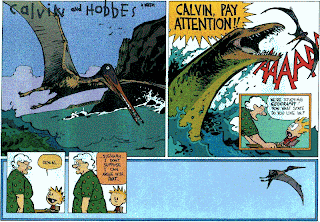 This strip focuses on the artwork more than the punchline. Aside from kazam, only three things total are said in the strip. This gives the reader no choice but to derive his ideas about the strip from the artwork. Ending the strip with the huge landscape of something from another planet is very atypical in Sunday comic strips, and leaves the reader sort of gazing into Watterson's art
This strip focuses on the artwork more than the punchline. Aside from kazam, only three things total are said in the strip. This gives the reader no choice but to derive his ideas about the strip from the artwork. Ending the strip with the huge landscape of something from another planet is very atypical in Sunday comic strips, and leaves the reader sort of gazing into Watterson's art
The realism in this strip is what makes the art noticeable. Calvin and Hobbes is a cartoon comic, with generally no realism in the usual characters. Watterson again stresses the art over Calvin and Hobbes, only including them in one panel of the strip. This forces the reader to recognize and somewhat appreciate the art.

The gothic artwork in this strip is pretty impressive. Shows what Calvin is really thinking when playing with his tinkertoys. He has his parents fooled, as they think he is going to grow up to be an architect. According to the strip he would rather grow up to be a dictator of some sort, or more preferably an ancient god... who demands sacrifice. Again, the sketches in this strip must have taken quite some time, and for Watterson to still not lose his excellent sense of humor is awesome.

This strip, aside from being amazingly clever in Wattersons ability to write poetry, has some interesting art in it. Its quite scientific, with the Earth being drawn well in the first panel, the draining of the ocean, and the futuristic space ship. Watterson dumbs this down in the last panel, showing the old fashioned megaphone that comes from the spaceship. Funny. Notice the "end is nigh" character in the third panel! Priceless.

In Watterson's tenth anniversary book, he talks about a comic strip this is based on. I cannot recall which it is based on, but it is supposed to be a parody of it. According to Watterson, the other strip is extremely boring, which made his parody an easy one. The strip is quite funny, i love how the irony progresses until the end of the strip. The art in this one goes without saying, the realism is there. The angles of the artwork would make for a difficult draw, but Watterson does a good job for being someone who primarily writes comics.

The art in this strip speaks for itself. Only three panels are devoted to the punchline, and even those three panels are a quarter of the size of the ones Watterson devotes to the artwork. It seems it would be difficult to fit the scene to the panel size, but Watterson does it perfectly and makes it look easy. The punch line is in and out, and not to mention quite funy.

 I put these two strips in here to really show how much Watterson knows about art. In his tenth anniversary book he really shows how wrapped up he is with art, even though he does not express it too much in his strips. I think the second strip here is just to blow the reader away with a bunch of nonsensical art vocabulary, which is intended to confuse, thus making it funny. I could be wrong, perhaps if I understood the vocabulary it would be even funnier. Feel free to comment if you understand it!
I put these two strips in here to really show how much Watterson knows about art. In his tenth anniversary book he really shows how wrapped up he is with art, even though he does not express it too much in his strips. I think the second strip here is just to blow the reader away with a bunch of nonsensical art vocabulary, which is intended to confuse, thus making it funny. I could be wrong, perhaps if I understood the vocabulary it would be even funnier. Feel free to comment if you understand it!
1 comment:
I absolutely love Calvin and Hobbes. Thanks for the post!
God bless,
Taylor J. Beisler
www.taylorbeisler.com
Post a Comment